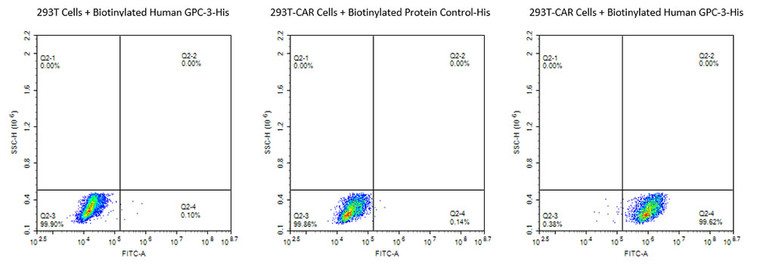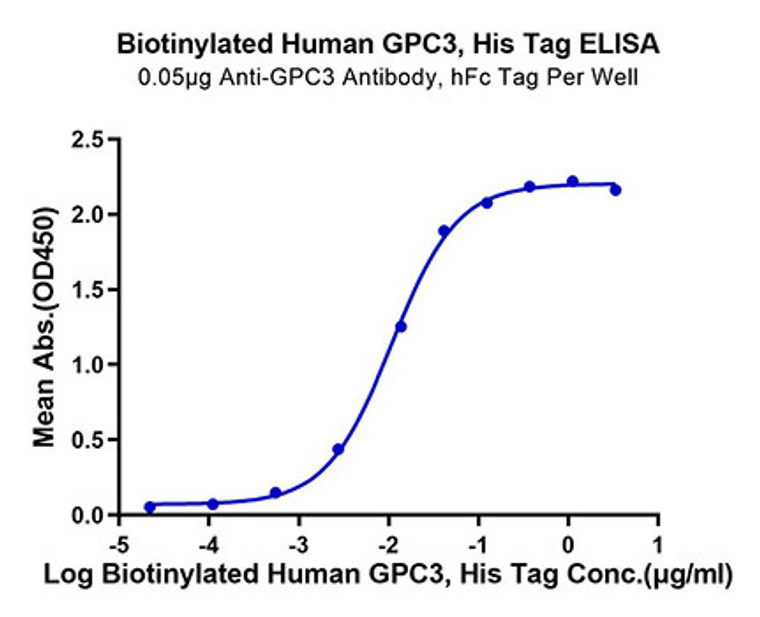| Host: |
HEK293 cells |
| Reactivity: |
Human |
| Note: |
STRICTLY FOR FURTHER SCIENTIFIC RESEARCH USE ONLY (RUO). MUST NOT TO BE USED IN DIAGNOSTIC OR THERAPEUTIC APPLICATIONS. |
| Short Description: |
Recombinant-Human Glypican-3/GPC3-C-His & Avi protein was developed from hek293 cells and has a target region of C-His & Avi. For use in research applications. |
| Conjugation: |
Biotin |
| Formulation: |
Lyophilized from a 0.22 Mu m filtered solution of PBS, pH 7.4. |
| Storage Instruction: |
Store at-20°C for up to 1 year from the date of receipt, and avoid repeat freeze-thaw cycles. |
| Immunoreactivity: |
Use Biotinylated Human GPC3-His protein to detect the expression rate of Anti-GPC3-CAR positive cells. 293T cells and anti-GPC3 CAR-293T cells were incubated with Biotinylated human GPC3-His (25-559) , His Tag and Biotinylated Protein Control-His. No |
| Gene Symbol: |
GPC3 |
| Gene ID: |
2719 |
| Uniprot ID: |
GPC3_HUMAN |
| Immunogen Region: |
Gln25-His559 |
| Immunogen: |
Biotinylated Recombinant Human GPC3 Protein is produced by Expi293 expression system. The target protein is expressed with sequence (Gln25-His559) of Human GPC3 fused with His tag and Avi tag at the C-terminal. |
| Post Translational Modifications | O-glycosylated.contains heparan sulfate and/or chondroitin sulfate. Cleaved intracellularly by a furin-like convertase to generate 2 subunits, alpha and beta, which remain associated through disulfide bonds and are associated with the cell surface via the GPI-anchor. This processing is essential for its role in inhibition of hedgehog signaling. A second proteolytic event may result in cleavage of the protein on the cell surface, separating it from the GPI-anchor and leading to its shedding from the cell surface. |
| Function | Cell surface proteoglycan. Negatively regulates the hedgehog signaling pathway when attached via the GPI-anchor to the cell surface by competing with the hedgehog receptor PTC1 for binding to hedgehog proteins. Binding to the hedgehog protein SHH triggers internalization of the complex by endocytosis and its subsequent lysosomal degradation. Positively regulates the canonical Wnt signaling pathway by binding to the Wnt receptor Frizzled and stimulating the binding of the Frizzled receptor to Wnt ligands. Positively regulates the non-canonical Wnt signaling pathway. Binds to CD81 which decreases the availability of free CD81 for binding to the transcriptional repressor HHEX, resulting in nuclear translocation of HHEX and transcriptional repression. Inhibits the dipeptidyl peptidase activity of DPP4. Plays a role in limb patterning and skeletal development by controlling the cellular response to BMP4. Modulates the effects of growth factors BMP2, BMP7 and FGF7 on renal branching morphogenesis. Required for coronary vascular development. Plays a role in regulating cell movements during gastrulation. |
| Protein Name | Glypican-3Gtr2-2Intestinal Protein Oci-5Mxr7 Cleaved Into - Glypican-3 Alpha Subunit - Glypican-3 Beta Subunit |
| Database Links | Reactome: R-HSA-1971475Reactome: R-HSA-2022928Reactome: R-HSA-2024096Reactome: R-HSA-3560783Reactome: R-HSA-3560801Reactome: R-HSA-3656237Reactome: R-HSA-3656253Reactome: R-HSA-381426Reactome: R-HSA-4420332Reactome: R-HSA-8957275Reactome: R-HSA-9694614Reactome: R-HSA-975634 |
| Cellular Localisation | Cell MembraneLipid-AnchorGpi-AnchorExtracellular Side |
| Alternative Protein Names | Glypican-3 proteinGtr2-2 proteinIntestinal Protein Oci-5 proteinMxr7 Cleaved Into - Glypican-3 Alpha Subunit - Glypican-3 Beta Subunit proteinGPC3 proteinOCI5 protein |
Information sourced from Uniprot.org
12 months for antibodies. 6 months for ELISA Kits. Please see website T&Cs for further guidance









